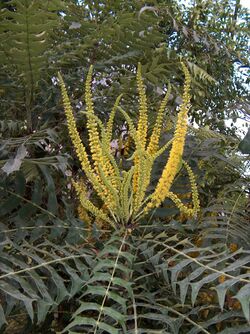Biology:Mahonia lomariifolia
Redirect page
Redirect to:
| Mahonia lomariifolia | |
|---|---|

| |
| Scientific classification | |
| Kingdom: | Plantae
|
| (unranked): | |
| (unranked): | |
| Order: | |
| Family: | |
| Genus: | |
| Species: | M. lomariifolia
|
| Binomial name | |
| Mahonia lomariifolia Takeda
| |
Mahonia lomariifolia, the Chinese hollygrape,[1] is a large upright growing shrub or small tree, up to 9 metres high. It is native to the region between Yunnan, Sichuan, northern Burma and east to Taiwan.
The foliage is borne in tufts at the top of the stems. The leaves have more leaflets than most species of Mahonia, usually up to 14-20 pairs of leaflets, with an additional terminal leaflet.
Yellow flowers are borne in racemose upright inflorescences at the tips of the branches, up to 25 cm long, in autumn. Between 7 and 20 racemes occur in each cluster. The flowers are bright deep yellow, and are slightly fragrant. Flowers emerge from October to November in the northern hemisphere and May to June in the southern hemisphere.
It is cultivated in gardens, often for foliage effect because of the large pinnate leaves, though it is unreliably hardy in northern latitudes. It is a parent of some notable garden hybrids, including Mahonia × media 'Charity'.
References
- ↑ "Mahonia lomariifolia". Natural Resources Conservation Service PLANTS Database. USDA. https://plants.usda.gov/core/profile?symbol=MALO8. Retrieved 28 June 2015.
- Hillier; Manual of Trees and Shrubs.
- C. D. Brickell; The hybrids between Mahonia japonica and M. lomariifolia. Published in 'The Plantsman', vol.1, 1979.
Wikidata ☰ Q159997 entry
